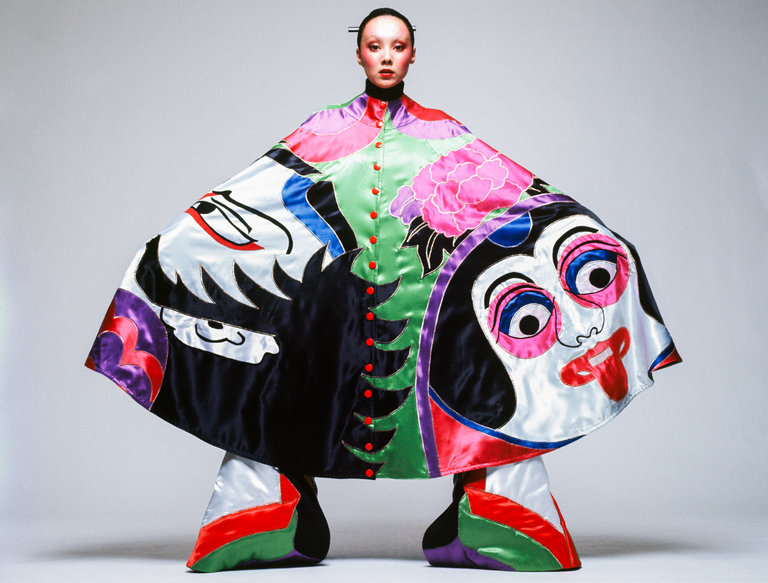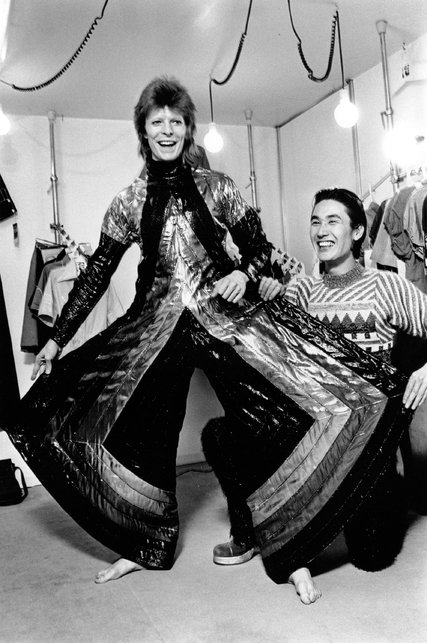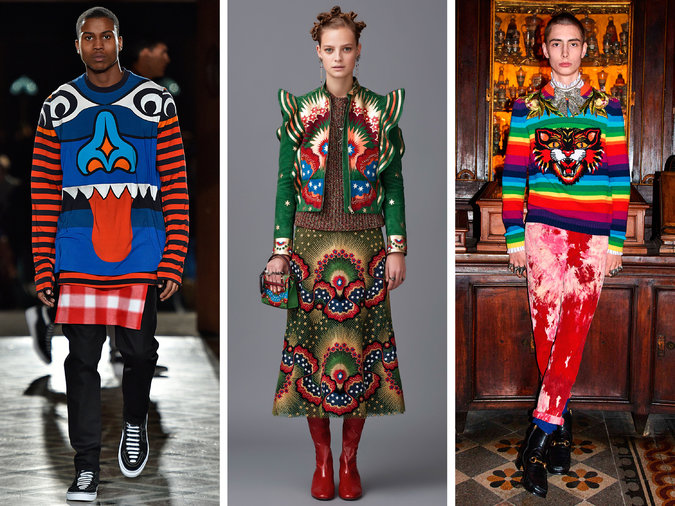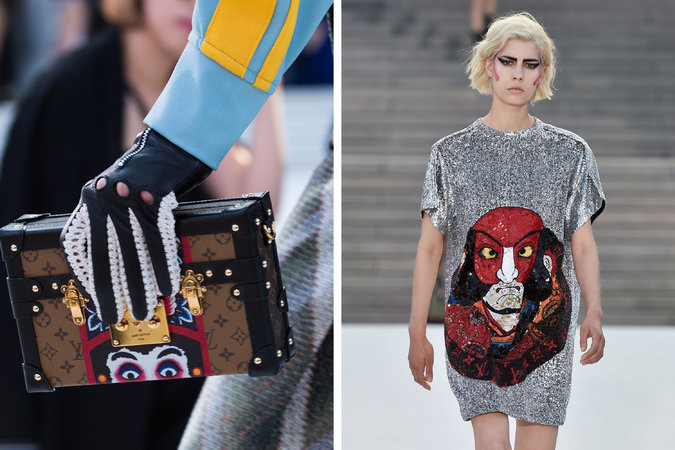
Kansai Yamamoto isn’t a name that readily trips off the tongue when speaking about Japanese fashion design. Yohji is the Yamamoto that leaps to mind, a designer who upended Western ideas of dress alongside Rei Kawakubo’s Comme des Garçons in Paris in the early 1980s.
But Kansai (perhaps to avoid confusion, he tends to be referred to by his first name, rather than his last) got there first: He showed in London in 1971, a full decade before Kawakubo and the other Yamamoto. And his singular aesthetic — overloaded with color, print and Asiatic art inspirations galore — is proving especially influential to designers today.
You may not know Kansai’s name, but you’d recognize his clothes — from David Bowie, if no-one else. In clashing synthetics and high-shine silks in a cacophony of jarring shades, they are loud, even obnoxious. With sculptural, abstract shapes (practicality be damned!), they’re ideal to be seen from the back of a stadium — which is probably what attracted Bowie to them in the first place. Bowie started wearing Kansai’s ostensibly commercial women’s wear on his 1972 “Ziggy Stardust” tour, subsequently collaborating with the designer to create one-off showpieces.

Born in Yokohama, on Japan’s east coast, Kansai graduated from Tokyo’s Bunka Fashion College (also the training ground for Yohji Yamamoto, as well as Junya Watanabe and Jun Takahashi of Undercover). He founded his own business, Yamamoto Kansai Company, Ltd, at 28. The London show followed the same year, garnering attention and securing Kansai’s debut the cover of British Harpers & Queen magazine. “Explosion From Tokyo” ran the coverline. That first show made enough waves to attract Bowie’s attention, whose Ziggy Stardust and Aladdin Sane tours cemented the Kansai aesthetic in popular culture.
Kansai allies his clothing to the Japanese concept of basara — a love of color and flamboyance. It’s also directly in contrast with the idea of wabi-sabi, the Buddhist ideal of the beauty in imperfection, modesty and humble materials. None of that is terribly Kansai. His clothes, by contrast, are more readily associated with the Azuchi–Momoyama period of Japanese art, a brief, opulent era between the mid-16th and early 17th centuries. The art of that period was pretty basara — lavish, decorative, often bold, even aggressive.

Kansai’s aesthetic is, strangely, seldom tagged as “Japanese.” Perhaps that’s because we tend to think of Japan as wabi-sabi rather than basara — the former being readily associated with the intentionally distressed output of Yohji Yamamoto and Rei Kawakubo from the early 1980s, a look the fashion press disparagingly dubbed “Bag Lady Chic” and which remains, even today, the defining look of “Japanese” fashion. By contrast, Kansai’s designs cherry-pick from Japanese history — and roam through Asian art as a whole, fusing disparate visuals — irezumi tattoos, Imperial Chinese court robes from the Qing dynasty, a print derived from Hokusai’s “The Great Wave Off Kanagawa” — into single garments. Kansai’s prints and visual treatments echo the two-dimensional nature of much Asian art — bold and graphic, rather than nuanced and detailed, with the rich, brilliant colors of porcelain or enamel. He loved a wide unfurling cape, both for its impact as a silhouette but also as a canvas for decoration, like a Chinese or Japanese screen, allowing a pictorial story to unfold. The theatricality of the overall effect was also quintessentially early-’70s — and fundamentally glam.

There’s something of a Kansai revival happening right now in fashion — or at least, a revival of his basara aesthetic. Kansai’s signature riot of color, texture and pattern is evident in Alessandro Michele’s most recent Gucci collections. Some designers have stuck closer than others to the Kansai style: The stated inspiration behind Valentino’s pre-fall 2016 collection was Elio Fiorucci, but a section that paid graphic homage to Japan (Mount Fuji included) looked pure Kansai. And Riccardo Tisci patterned his final Givenchy men’s wear collection in January with totem-pole graphics that bear uncanny similarities to Kansai’s gurning faces, with tongues protruding, inspired by the caricatured yakko (soldier) masks of Japanese theatre. Nicolas Ghesquiere at Louis Vuitton paid the most overt homage in his 2018 cruise show, which was held in Kyoto: He actually enlisted Kansai himself (who is now 73) to create several new graphics, including reworks of those grimacing yakko faces across brief shifts and boxy petit malle handbags.
That these contemporary brands are collaborating (or liberally borrowing) from Kansai’s obscure archive is less interesting than why. Why Kansai right now? Kansai’s clothes characterize a specific breed of 1970s escapism — into outer space, to new and imaginary cultures, to the future, from the past, shedding gender while you were at it. Glam rock — which Kansai’s designs for Bowie helped to fundamentally shape aesthetically — was about dreaming, about offering a certain unreality as a salve to troubled times. It was a colorful, campy distraction from terrorism, economic strife, the Yom Kippur and Vietnam Wars, and the crooked politicians of Watergate.
Ring any bells?